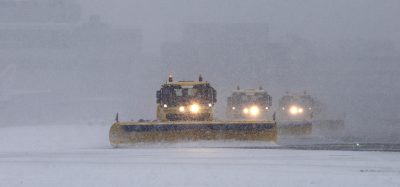Learning from the past
- Like
- Digg
- Del
- Tumblr
- VKontakte
- Buffer
- Love This
- Odnoklassniki
- Meneame
- Blogger
- Amazon
- Yahoo Mail
- Gmail
- AOL
- Newsvine
- HackerNews
- Evernote
- MySpace
- Mail.ru
- Viadeo
- Line
- Comments
- Yummly
- SMS
- Viber
- Telegram
- Subscribe
- Skype
- Facebook Messenger
- Kakao
- LiveJournal
- Yammer
- Edgar
- Fintel
- Mix
- Instapaper
- Copy Link
Posted: 7 February 2012 | Jan Michalak, Head of Warsaw Chopin Airport Maintenance Service | No comments yet
Warsaw Chopin Airport has spent a large amount of investment on winter main – tenance during the 2010/11 season. Never before in the airport’s history had the struggle with snow and ice required so much effort and resources. So what can we expect in 2012?
According to data from the Polish Institute of Meteorology and Water Management, the previous winter was exceptionally cold. The average temperature during the three winter months was -3°C, which was more than two degrees colder than usual. As we all know the 2011/2012 was particularly harsh, causing travel chaos across Europe.
In Warsaw, the number of snowfall periods (12 hour work shifts during which snow removal was required) totalled 85 and was similar to that of the two previous seasons. The number of melt-freeze periods was also above average at approximately 96. However, due to heavy snowfall, as well as rapid weather changes, Chopin Airport’s snow-removal service had their hands full.
Warsaw Chopin Airport has spent a large amount of investment on winter main – tenance during the 2010/11 season. Never before in the airport’s history had the struggle with snow and ice required so much effort and resources. So what can we expect in 2012? According to data from the Polish Institute of Meteorology and Water Management, the previous winter was exceptionally cold. The average temperature during the three winter months was -3°C, which was more than two degrees colder than usual. As we all know the 2011/2012 was particularly harsh, causing travel chaos across Europe. In Warsaw, the number of snowfall periods (12 hour work shifts during which snow removal was required) totalled 85 and was similar to that of the two previous seasons. The number of melt-freeze periods was also above average at approximately 96. However, due to heavy snowfall, as well as rapid weather changes, Chopin Airport’s snow-removal service had their hands full.
Thousands of overtime hours
The airport was eventually brought to a standstill, as 20 centimetres of snow fell in just two hours. The snow was so heavy that the runway was covered almost immediately after the passing of the snow-clearing convoy. Naturally, in such conditions the airport had to be closed to all traffic for an hour. However, it is worth noting that it was one of just two short closures of Chopin Airport during the whole 2010/11 winter season. All available staff from the airport’s pavement maintenance service (160 people) was involved in snow-clearing tasks. The service was divided into units and worked around the clock, keeping the airport operational and performing prompt repairs at on-site or simply remaining on-call whilst off-duty in case of emergencies. The number of overtime hours was recorded at 8,852 (which was the highest in over a decade) and is the best illustration of the magnitude of the effort. Thanks to the dedication of the staff, Chopin Airport remained open with virtually no interruption.
The best equipment
During this winter season the Airport Maintenance Service will have at its disposal 10 state-of-the-art, highly-efficient MB2041/ Øveraasen snow-removal sets (each equipped with a plough, brush and a high-powered blower mounted on a man-manufactured chassis). Six of these were already in use last winter, while the other four were delivered in September 2011, with 85 per cent financing from the EU’s European Regional Development Fund. The new technologically advanced vehicles make it possible to clear a 4km runway in just one 20 minute drive. No other airport in Poland and only a handful in Central and Eastern Europe can boast similar resources. Chopin Airport has also bought a new l arge Damman spreader with a capacity of 20 thousand litres of liquid de-icing agent and a reach of 36m, allowing for the application of chemicals on both of the airport’s runways in a single drive without refuelling. Apart from the newly purchased vehicles, the fleet includes older runway sweepers, ploughs and auxiliary equipment. In total, Chopin Airport has nearly 80 winter-maintenance machines.
Record expenses
Thanks to its large supply of eco-friendly de-icing chemicals (solid and liquid formulates), the airport is ready for even the harshest winter. The 2010/11 season was unprecedented in terms of the amount of chemicals used. During the most severe weather conditions between October and December 2010, the airport spent 234 per cent more de-icing chemicals than the average for the previous 11 seasons and 137 per cent more than in the 2009/10 season. Even though the second half of the winter was milder, the total consumption of chemicals reached a record 2,100 tonnes (40 per cent up on 2009/10). The expenses on de-icing agents were also much more higher than normal. Ultimately, the 2010/2011 winter season cost the airport an all-time high of over 10.8 million Zlotys, which included expenses on spare parts such as sweeper brushes and plough blades, as well as fuel and snow disposal.
Temperature trouble
Similar funds have been allocated for the current winter season, but the actual cost is hard to predict, as it always depends on the weather. Understandably, if the winter is long and harsh, the airport will have to spend more. But the climate changes constantly, so one can never be sure of anything. The airport’s biggest concern is heavy snowfall and the temperature hovering at around freezing, which is often the case in intermediate climate zones. The temperature can drop from positive to around -2°C, only to rise above the melting point again in just a few minutes, sometimes several times during one day. The situation is further complicated by the fact that the microclimatic conditions tend to vary locally, contributing to the formation of black ice, which is a major threat to air traffic. That is why early warning of icy conditions is crucial. Chopin Airport relies on state-of-the-art technology for winter maintenance. Since 1996, the airport has used the IceAlert system manufactured by the Swiss company Boschung. Fully upgraded in 2011, the system consists of six measurement points located on both runways and set in the pavement. Each is equipped with a completely unique, patent protected BOSO™ and ARCTIS™ runway sensors and data processors. The sensors are able to detect conditions in which the ice is likely to form. This is made possible by automatic computer analysis of a number of parameters, including air and surface temperature, surface dampness, relative air humidity etc. The system has proved an invaluable tool for the Airport Maintenance Service and Airport Duty Officers. By combining human experience with modern technology the effects of such phenomena as black ice can be effectively prevented, ensuring the highest safety standards. Given all this, it is clear that Chopin Airport is well prepared for the upcoming winter. We will do everything in our power to make sure that passengers and cargo arrive in Warsaw on time and without problems. But with nature, there are no guarantees.
Warsaw winter facts
The 2010/2011 ‘Operation Winter’ season started on 25 November 2010 and continued until 25 March 2011. According to the Institute of Meteorology and Water Management it was one of the coldest winters in Poland’s recent history. In the 2010/11 season the Airport Pavements Maintenance Division had six new MB2041/Øveraasen runway sweepers. Four more were delivered in September 2011. Social media proved invaluable as a means of informing passengers about the situation at the airport. The number of Chopin Airport Facebook users doubled in November and December and the airport’s English-language Twitter profile received much recognition from foreign users. (www.twitter.com/chopinairport).
About the author
Jan Michalak has worked at Warsaw airport for 32 years. Since 2000 he has been the Head of the Chopin Airport Maintenance Service, which comprises 270 staff working in 10 units. The Service’s responsibilities include maintaining airport infrastructure and equipment, in particular looking after pavements, grass surfaces, buildings and facilities, repairing equipment and vehicles, transportation, water and sewage management and, finally, technical consulting and supervision.

















